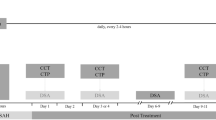Abstract
Object
Surgical revascularization for moyamoya disease prevents cerebral ischemic attacks by improving cerebral blood flow (CBF). It is undetermined, however, how rapid increase in CBF affects chronic ischemic brain during the acute stage in childhood moyamoya disease.
Materials and methods
The present study includes nine consecutive cases of patients with childhood moyamoya disease (2~8 years old, 6.2 in average), who underwent superficial temporal artery–middle cerebral artery (STA–MCA) anastomosis on 17 hemispheres. We prospectively performed single-photon emission computed tomography 1 and 7 days after 17 surgeries. The follow-up period ranged from 12 to 37 months (24.9 in average).
Results
The outcome of 17 surgeries was excellent (disappearance of transient ischemic attack) in 14 hemispheres (82.4%) and good (reduction of transient ischemic attack) in three hemispheres (17.6%). No patient suffered peri-operative infarction, except for one (5.9%) manifesting as pseudolaminar necrosis in a part of the cerebral cortex supplied by STA–MCA bypass at the subacute stage, which did not affect his long-term neurological status. One patient (5.9%) presented with transient facial palsy due to hyperperfusion, which resolved within several days. No patient manifested permanent neurological deterioration during the follow-up period.
Conclusion
The STA–MCA anastomosis is a safe and effective treatment for childhood moyamoya disease. We recommend routine CBF measurement for avoiding surgical complications including both cerebral ischemia and hyperperfusion.




Similar content being viewed by others
References
Choi JU, Kim DS, Kim EY, Lee KC (1997) Natural history of moyamoya disease: comparison of activity of daily living in surgery and non surgery groups. Clin Neurol Neurosurg 99(Suppl 2):S11–S18
Fujimura M, Morita-Fujimura Y, Noshita N, Sugawara T, Kawase M, Chan PH (2000) Cytosolic antioxidant copper, zinc-superoxide dismutase prevents the early release of mitochondrial cytochrome c in ischemic brain after transient focal cerebral ischemia in mice. J Neurosci 20:2817–2824
Fujimura M, Tominaga T, Chan PH (2005) Neuroprotective effect of antioxidant in cerebral ischemia: role of neuronal apoptosis. Neurocrit Care 2:59–66
Fujimura M, Kaneta T, Mugikura S, Shimizu H, Tominaga T (2007) Temporary neurologic deterioration due to cerebral hyperperfusion after superficial temporal artery–middle cerebral artery anastomosis in patients with adult-onset moyamoya disease. Surg Neurol 67:273–282
Fujimura M, Kaneta T, Shimizu H, Tominaga T (2007) Symptomatic hyperperfusion after superficial temporal artery–middle cerebral artery anastomosis in a child with moyamoya disease. Childs Nerv Syst 23:1195–1198
Fujimura M, Shimizu H, Mugikura S, Tominaga T (2008) Delayed intracerebral hemorrhage after superficial temporal artery–middle cerebral artery anastomosis in a patients with moyamoya disease: possible involvement of cerebral hyperperfusion and increased vascular permeability. Surg Neurol (in press)
Furuya K, Kawahara N, Morita A, Momose T, Aoki S, Kirino T (2004) Focal hyperperfusion after superficial temporal artery–middle cerebral artery anastomosis in a patient with moyamoya disease. Case report. J Neurosurg 100:128–132
Heros RC, Scott RM, Ackerman RH, Conner ES (1984) Temporary neurological deterioration after extracranial–intracranial bypass. Neurosurgery 15:178–185
Houkin K, Ishikawa T, Yoshimoto T, Abe H (1997) Direct and indirect revascularization for moyamoya disease: surgical techniques and peri-operative complications. Clin Neurol Neurosurg 99(Suppl 2):S142–145
Houkin K, Nonaka T, Baba T (2005) Peri-operative complications in surgical treatment for moyamoya disease. Annual report 2004 by the Research Committee on Spontaneous Occlusion of the Circle of Willis (moyamoya disease), pp 47–50
Ishikawa T, Houkin K, Kamiyama H, Abe H (1997) Effects of surgical revascularization on outcome of patients with pediatric moyamoya disease. Stroke 28:1170–1173
Kim SK, Wang KC, Kim IO, Lee DS, Cho BK (2002) Combined encephaloduroarteriosynangiosis and bifrontal encephalogaleo(periosteal)synangiosis in pediatric moyamoya disease. Neurosurgery 50:88–96
Matsushima T, Inoue TK, Suzuki SO, Inoue T, Ikezaki K, Fukui M (1997) Surgical techniques and the results of a fronto-temporo-parietal combined indirect bypass procedure for children with moyamoya disease: a comparison with the results of encephalo-duro-arterio-synangiosis alone. Clin Neurol Neurosurg 99(Suppl 2):S123–S127
Ogasawara K, Inoue T, Kobayashi M, Endo H, Fukuda T, Ogawa A (2004) Pretreatment with the free radical scavenger edaravone prevents cerebral hyperperfusion after carotid endarterectomy. Neurosurgery 55:1060–1067
Ogasawara K, Komoribayashi N, Kobayashi M, Fukuda T, Inoue T, Yamada K, Ogawa A (2005) Neural damage caused by cerebral hyperperfusion after arterial bypass surgery in a patient with moyamoya disease: case report. Neurosurgery 56:E1380
Ogasawara K, Yamadate K, Kobayashi M, Endo H, Fukuda T, Yoshida K, Terasaki K, Inoue T, Ogawa A (2005) Postoperative cerebral hyperperfusion associated with impaired cognitive function in patients undergoing carotid endarterectomy. J Neurosurg 102:38–44
Scott RM, Smith JL, Robertson RL, Madsen JR, Soriano SG, Rockoff MA (2004) Long-term outcome in children with moyamoya syndrome after cranial revascularization by pial synangiosis. J Neurosurg 100(2 Suppl Pediatrics):142–149
Shirane R, Yoshida Y, Takahashi T, Yoshimoto T (1997) Assessment of encephalo-galeo-myo-synangiosis with dural pedicle insertion in childhood moyamoya disease: characteristics of cerebral blood flow and oxygen metabolism. Clin Neurol Neurosurg 99(Suppl 2):S79–S85
Suzuki J, Takaku A (1969) Cerebrovascular ‘moyamoya’ disease. Disease showing abnormal net-like vessels in base of brain. Arch Neurol 20:288–299
Taki W, Tanaka M, Miyamoto S, Nagata I, Kikuchi H (1995) Postoperative transient neurological deficit in children with moyamoya disease. Annual report 1994 by the Research Committee on Spontaneous Occlusion of the Circle of Willis (moyamoya disease), pp 88–93
van Mook R, Rennenberg G, Schurink R, van Oostenbrugge W, Mess P, Hofman P (2005) Cerebral hyperperfusion syndrome. Lancet Neurol 4:877–888
Author information
Authors and Affiliations
Corresponding author
Rights and permissions
About this article
Cite this article
Fujimura, M., Kaneta, T. & Tominaga, T. Efficacy of superficial temporal artery–middle cerebral artery anastomosis with routine postoperative cerebral blood flow measurement during the acute stage in childhood moyamoya disease. Childs Nerv Syst 24, 827–832 (2008). https://doi.org/10.1007/s00381-007-0551-y
Received:
Published:
Issue Date:
DOI: https://doi.org/10.1007/s00381-007-0551-y




